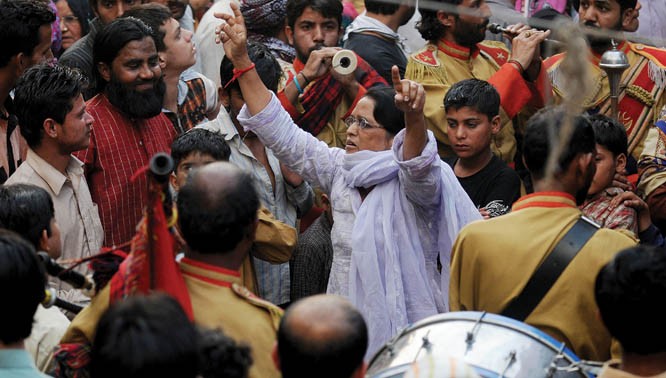
Shah Hussain was reviled, discriminated against and treated as a pariah but he has outlived them all through the sheer aesthetic delight of his poetry

Once billed as the biggest festival of the Punjab and one of the biggest in the subcontinent, Mela Chiraghan is but a shadow of its former glory.
The city has expanded so much that the location of the festival is only a maze of winding narrow streets and the shrine is hemmed and lost in comparatively bigger and recent structures. One has to look for the shrine now while in the past it stood alone with ample spaces around it.
It may be added that Shah Hussain and Mela Chiraghan were never a constant toast of the leading and ruling classes of the area. Probably during the Sikh rule, it became a huge affair with full patronage extended by Maharaja Ranjeet Singh. It became an annual event that celebrated spring on a very grand scale. The venue of the festival was the Shalimar Gardens, and the major events in which the maharaja himself took part were held there.
It could be that, being the first Punjabi ruler in a thousand years, Ranjeet Singh insisted on making it as a mission statement for establishing the culture of the Punjab. For the Punjabis, like other Muslims in the subcontinent, have had multiple royalties -- towards their past, the land and faith. Often the Muslim rule is promoted as a monolithic overarching benediction that was lauded for it provided succour to the Muslim population in general. But we know that this is either a construct or a tendentious reading of history. The best example of that could be the life and struggles of Shah Hussain himself.
The sufis and the institutions they represented were said to be against worldly affairs as they spent their lives as recluses in comparative terms, keeping away from the power struggles that usually are the trappings of power politics. But we also know that these institutions and personages did stand for justice and fairplay, over and above religious royalties. This was probably the reason for their trans-religious following and standing.
One has not really analysed the role of Shah Hussain in the various resistance movements that had characterised the Punjab at the time that he was alive. It is often said that he was not totally enamoured of the centralised Mughal rule and their exploitative policies of extracting taxes from the peasantry. His name was often taken in the same breath as the peasant uprising that followed the arrest and execution of Dullah Bhatti. It is also said that he was incarcerated and was seen to be a supporter of the Punjabis, and thus seen as a traitor by the Mughal ruling elite.
Akbar had also moved his capital to Lahore for about fifteen years as he had problems in crushing the various movements that were fomenting in the Punjab. He was also having massive problems with the insurrection and rebellion in the North West, stretching right up to what is now called Afghanistan. It was easier for him to oversee his campaign from Lahore than Fatehpur Sikri or Agra, and his policies were resented by the local elite in the Punjab and the North West. Most of the early Pushto poetry is the galvanisation of the Pukhtoon sentiment against this very imperial Mughal rule.
The Bhagti movement was basically interfaith affair. It also championed the cause of the lower/working classes. There was much that was created in that period, including the proper formulation of the Punjabi language. The language started to show definite signs of maturity in the fourteenth century with the sufis and the bhagtis being its leading proponents. By the time Shah Hussain appeared on the scene, it was ready to receive the kiss of life. Shah Hussain obliged and was responsible for taking it across the Rubicon -- from a dialect to a language, if seen in a more formal context.
It was at that time a great confluence of the streams of music, language, religious thought, poetic idiom and artistic sensibility which the sufia were in the process of employing creatively. They wrote and spoke in local languages, looked beyond the division imposed by ritual and valued the supreme joy of existence. A personalised experience of truth was more authentic than the sophistry of scholastic reasoning. The lafz and the sur, the ista’ara and the behlawa came together to form an integrated vision which led to no differentiation between life and death.
Shah Hussain actually formalised the standard idiom of Punjabi poetry. Building on the foundation laid by Baba Fareed, he gave it the accent that was to dominate Punjabi poetry for the next four hundred years before the educated Punjabis started to write in Urdu after the arrival of the British. He engaged the characters of Heer and Ranjha for the first time in kafi as symbols of an existence that was both meaningful and joyous. It carried within itself the supreme inspiration of love and the fear of its travails.
In an age that is increasingly feasting on sanctimony, the life of Shah Hussain is looked askance at, and kept at some distance by those promoting a goody goody cleansed image of the past. The malamatia strain that Shah Hussain represented has fallen out of favour as the sufis are seen more as agents aligning tareeqat with shariat. Though he led a life that was very active and extremely volatile, bordering on irreverence, his poetry did not have the violence of Bulleh Shah.
Shah Hussain was much more restrained and paid greater respect to the artistic value of detachment in arts than did his successor. For him, truth and authentic existence mattered more than the tame application of received truth. So, he was reviled, discriminated against and treated as a pariah but he has outlived them all through the sheer aesthetic delight of his poetry.